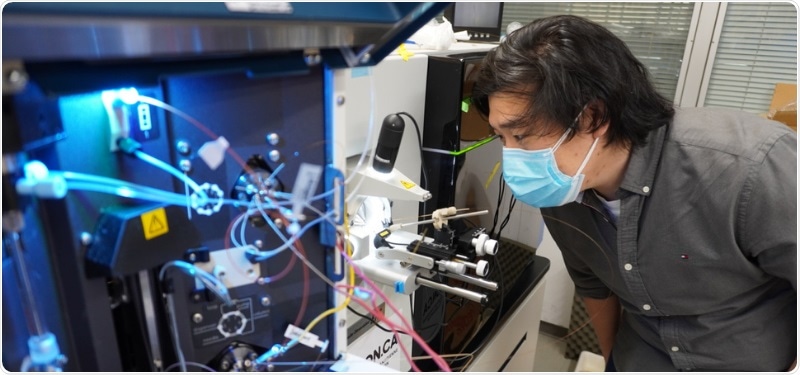Sinai Health researchers published a study that offers an ultra-detailed look into the arrangement of a living human cell, giving a new tool that can assist scientists all across the globe to better understand what happens during disease.

Co-first author Christopher Go surveyed the human cell landscape using 192 markers for proteins known to reside in specific organelles that can “tag” neighboring proteins in the same compartment. Image Credit: Sinai Health.
The research was carried out in the laboratory of Dr. Anne-Claude Gingras, a senior investigator at the Lunenfeld-Tanenbaum Research Institute (LTRI) and professor in the Department of Molecular Genetics at the University of Toronto.
Christopher Go and Dr. James Knight, co-first authors, investigated the human cell landscape with 192 markers for proteins known to exist in certain organelles and that may “tag” neighboring proteins in the same compartment.
The Human Cell Map was able to predict the localization of 4,000 proteins across all compartments in living human cells. We sampled all the major organelles of the human cell and used innovative analysis to create the highest resolution map to date, with high accuracy in predicting novel localizations for many unmapped proteins.”
Christopher Go, Co-First Author, Lunenfeld-Tanenbaum Research Institute (LTRI)
The human body is made up of trillions of cells that are further divided into numerous compartments with specific functions, just like a house has distinct rooms for sleeping and cooking.
These compartments, known as organelles, each contain a unique set of proteins that carry out specialized functions connected with the compartment. One example of an organelle is the mitochondria, sometimes known as the cell’s powerhouse.
According to the researchers, knowing which proteins reside in which organelles are a critical first step in understanding the purpose of each cellular protein. Earlier efforts frequently employed procedures that killed the cells first before attempting to separate the organelles from one another.
Previously, it was like taking the house apart to isolate each of the individual rooms. These approaches tend to provide only crude views of the organization of a cell.”
Christopher Go, Co-First Author, Lunenfeld-Tanenbaum Research Institute (LTRI)
The Gingras lab creates techniques for detecting proteins using mass spectrometers. The proteins that are “tagged” by organelle markers were isolated and identified using mass spectrometry in the latest study. After that, the scientists employed computational methods to rebuild the human cell.
Through our research, we have shown that we can precisely localize thousands of proteins at a time with relatively little effort. Previous methods for localizing a protein required each protein to be investigated individually, or required a limited focus.”
Dr James Knight, Bioinformatician, Gingras Lab, Lunenfeld-Tanenbaum Research Institute (LTRI)
Given the vastness of the Human Cell Map, the team also established an analytical portal to allow academics from all around the world to look deeper into the information. Users can thoroughly examine each of the 192 markers and compare their own protein localization data to predictions generated by the Human Cell Map.
While this research gives a better knowledge of the organization of the human cell, Knight believes it may also be used to better understand what happens during disease.
“Human diseases are typically characterized at the molecular level by proteins with aberrant behavior that cause the cell to behave in pathological ways. In these situations, proteins will often change where they reside in the cell,” said Dr. Knight.
“Our research is a first step in addressing this challenge in normal cells and we can use it for comparisons against altered cell states, such as disease conditions, to identify proteins with unexpected localizations that may help us understand a diseased cell better,” added Dr. Knight.
The map will now be utilized in a number of studies to help shed more light on protein localization in human cells, according to the researchers. Chemical, viral, and disease conditions will be used in the future to better define how cells respond structurally to various stresses.
This can help guide future research efforts aimed at gaining a mechanistic knowledge of disease states and developing future treatments.
Source:
Journal reference:
Go, C. D., et al. (2021) A proximity-dependent biotinylation map of a human cell. Nature. doi.org/10.1038/s41586-021-03592-2.